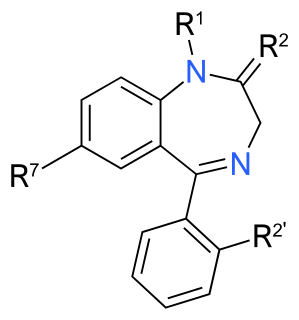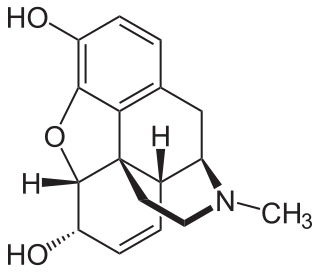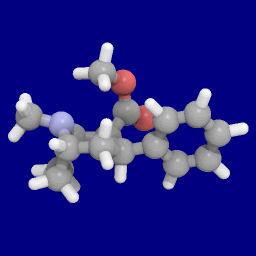 W
WAlcohol dependence is a previous psychiatric diagnosis in which an individual is physically or psychologically dependent upon alcohol.
 W
WAlcoholism is, broadly, any drinking of alcohol that results in significant mental or physical health problems. Alcoholism is not a recognized diagnostic entity. Predominant diagnostic classifications are alcohol use disorder (DSM-5) or alcohol dependence (ICD-11).
 W
WAmphetamine dependence refers to a state of psychological dependence on a drug in the amphetamine class. Dependence on amphetamines seems to be on a rise; one study has shown that drug films heavily influence the sensations of craving in drugs, something that can contribute to amphetamine dependence. Stimulants such as amphetamines and cocaine, however, do not cause physical dependence.
 W
WBenzodiazepine dependence defines a situation in which one has developed one or more of either tolerance, withdrawal symptoms, drug seeking behaviors, such as continued use despite harmful effects, and maladaptive pattern of substance use, according to the DSM-IV. In the case of benzodiazepine dependence, however, the continued use seems to be associated with the avoidance of unpleasant withdrawal reaction rather than from the pleasurable effects of the drug. Benzodiazepine dependence develops with long-term use, even at low therapeutic doses, without the described dependence behavior.
 W
WBenzodiazepine use disorder (BUD), also called misuse or abuse, is the use of benzodiazepines without a prescription, often for recreational purposes, which poses risks of dependence, withdrawal and other long-term effects. Benzodiazepines are one of the more common prescription drugs used recreationally. When used recreationally benzodiazepines are usually administered orally but sometimes they are taken intranasally or intravenously. Recreational use produces effects similar to alcohol intoxication.
 W
WBenzodiazepine withdrawal syndrome—often abbreviated to benzo withdrawal or BZD withdrawal —is the cluster of signs and symptoms that emerge when a person who has been taking benzodiazepines, either medically or recreationally, and has developed a physical dependence, undergoes dosage reduction or discontinuation. Development of physical dependence and the resulting withdrawal symptoms, some of which may last for years, may result from taking the medication as prescribed. Benzodiazepine withdrawal is characterized by sleep disturbance, irritability, increased tension and anxiety, panic attacks, hand tremor, shaking, sweating, difficulty with concentration, confusion and cognitive difficulty, memory problems, dry retching and nausea, weight loss, palpitations, headache, muscular pain and stiffness, a host of perceptual changes, hallucinations, seizures, psychosis, and increased risk of suicide. Further, these symptoms are notable for the manner in which they wax and wane and vary in severity from day to day or week by week instead of steadily decreasing in a straightforward monotonic manner. This phenomenon is often referred to as "waves" and "windows".
 W
WThe Book of Drugs is a 2012 memoir by the musician and songwriter Mike Doughty. The book details Doughty's struggles with drug addiction, his musical career, both before and during his time with the band Soul Coughing and during his solo career.
 W
WCaffeine is a commonplace central nervous system stimulant drug which occurs in nature as part of the coffee, tea, yerba mate, cocoa and other plants. It is also an additive in many consumer products, most notably beverages advertised as energy drinks and colas.
 W
WSamuel Taylor Coleridge was an English poet, critic, and philosopher who consumed opium to address his health issues. His use of opium in his home country of England, as well as Sicily and Malta, is extensively documented. Coleridge's opium use led to severe consequences. Coupled with his health conditions, it harmed his life and adversely impacted his career.
 W
WThe Comprehensive Addiction and Recovery Act (CARA) was signed into law by President Obama on July 22, 2016. The bill was introduced by Senator Sheldon Whitehouse and Representative Jim Sensenbrenner as the first major federal addiction act in 40 years.
 W
WThe Contender is the debut novel by American author and sports journalist Robert Lipsyte. It was published in 1967.
 W
WCrystal Darkness is a 30-minute Emmy and Telly Award-winning documentary on the dangers and prevalence of the drug methamphetamine. The film features testimonies of young people who have gone through meth addiction, as well as interviews with high-profile politicians and law enforcement officials.
 W
WIndatraline is a non-selective monoamine transporter inhibitor that has been shown to block the reuptake of dopamine, norepinephrine, and serotonin with effects similar to those of cocaine. However, the effects have been shown to have slower onset and longer duration than cocaine, suggesting that the compound may, along with similar compounds, be used for treatment of cocaine addiction. Apparently, Lu 19-005 can be used to block the action of methamphetamine and MDMA.
 W
WThe effects of long-term benzodiazepine use include drug dependence and neurotoxicity as well as the possibility of adverse effects on cognitive function, physical health, and mental health. Long term use is sometimes described as use not shorter than three months. Benzodiazepines are generally effective when used therapeutically in the short term, but even then the risk of dependency can be significantly high. There are significant physical, mental and social risks associated with the long-term use of benzodiazepines. Although anxiety can temporarily increase as a withdrawal symptom, there is evidence that a reduction or withdrawal from benzodiazepines can lead in the long run to a reduction of anxiety symptoms. Due to these increasing physical and mental symptoms from long-term use of benzodiazepines, slow withdrawal is recommended for long-term users. Not everyone, however, experiences problems with long-term use.
 W
WNicotine dependence is a state of dependence upon nicotine. Nicotine dependence is a chronic, relapsing disease defined as a compulsive craving to use the drug, despite social consequences, loss of control over drug intake, and emergence of withdrawal symptoms. Tolerance is another component of drug dependence. Nicotine dependence develops over time as a person continues to use nicotine. The most commonly used tobacco product is cigarettes, but all forms of tobacco use and e-cigarette use can cause dependence. Nicotine dependence is a serious public health problem because it leads to continued tobacco use, which is one of the leading preventable causes of death worldwide, causing more than 8 million deaths per year.
 W
WOpioid use disorder (OUD) is a substance use disorder relating to the use of an opioid. Any such disorder causes significant impairment or distress. Signs of the disorder include a strong desire to use opioids, increased tolerance to opioids, difficulty fulfilling obligations, trouble reducing use, and withdrawal symptoms with discontinuation. Opioid withdrawal symptoms may include nausea, muscle aches, diarrhea, trouble sleeping, agitation, and a low mood. Addiction and dependence are components of a substance use disorder. Complications may include opioid overdose, suicide, HIV/AIDS, hepatitis C, and problems at school, work, or home.
 W
WThe Pharmacy Act 1868 was an Act of the Parliament of the United Kingdom. It was the major 19th-century legislation in the United Kingdom limiting the sale of poisons and dangerous drugs to qualified pharmacists and druggists.
 W
WPhenyltropanes (PTs) were originally developed to reduce cocaine addiction and dependency. In general these compounds act as inhibitors of the plasmalemmal monoamine reuptake transporters. Although RTI holds a strong position in this field, they are not the only researchers that have prepared these analogues. This research has spanned beyond the last couple decades, and has picked up its pace in recent times, creating numerous phenyltropanes as research into cocaine analogues garners interest to treat addiction.
 W
WProblematic smartphone use is proposed by some researchers to be a form of psychological or behavioral dependence on cell phones, closely related to other forms of digital media overuse such as social media addiction or internet addiction disorder. Other researchers have stated that terminology relating to behavioral addictions in regards to smartphone use can cause additional problems both in research and stigmatization of users, suggesting the term to evolve to problematic smartphone use. Problematic use can include preoccupation with mobile communication, excessive money or time spent on mobile phones, and use of mobile phones in socially or physically inappropriate situations such as driving an automobile. Increased use can also lead to increased time on mobile communication, adverse effects on relationships, and anxiety if separated from a mobile phone or sufficient signal. Technology is an ever growing and advancing industry that has changed the way views and live in the modern world. Phones, which were once considered a luxury item, are now a necessity that can effectively control all aspects of person's lives including banking information, work life, credit/debit cards, and people social interactions as well with the presence of social media. Depression symptom severity was negatively associated with greater social smartphone use. Process smartphone use was more strongly associated with problematic smartphone use. Finally, process smartphone use accounted for relationships between anxiety severity and problematic smartphone use.
 W
WSupervised injection sites (SIS) are medically supervised facilities designed to provide a hygienic environment in which people are able to consume illicit recreational drugs intravenously. The legality of such a facility is dependent by location and political jurisdiction. Supervised injection sites are part of a harm reduction approach towards drug problems. The facilities provide sterile injection equipment, information about drugs and basic health care, treatment referrals, access to medical staff, and, at some facilities, counseling. Most programs prohibit the sale or purchase of recreational drugs at the facility.
 W
WSubstance abuse prevention, also known as drug abuse prevention, is a process that attempts to prevent the onset of substance use or limit the development of problems associated with using psychoactive substances. Prevention efforts may focus on the individual or their surroundings. A concept that is known as "environmental prevention" focuses on changing community conditions or policies so that the availability of substances is reduced as well as the demand. Individual Substance Abuse Prevention, also known as drug abuse prevention involves numerous amounts of different sessions depending on the individual to help cease or reduce the use of substances. The time period to help a specific individual can vary based upon many aspects of an individual. The type of Prevention efforts should be based upon the individual's necessities which can also vary.
 W
WSubstance use disorder (SUD) is the persistent use of drugs despite substantial harm and adverse consequences. Substance use disorders are characterized by an array of mental/emotional, physical, and behavioral problems such as chronic guilt; an inability to reduce or stop consuming the substance(s) despite repeated attempts; driving while intoxicated; and physiological withdrawal symptoms. Drug classes that are involved in SUD include: alcohol; cannabis; phencyclidine and other hallucinogens, such as arylcyclohexylamines; inhalants; opioids; sedatives, hypnotics, or anxiolytics; stimulants; tobacco; and other or unknown substances.